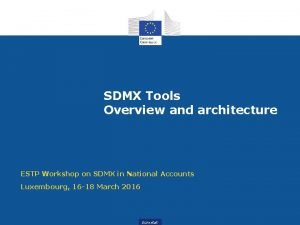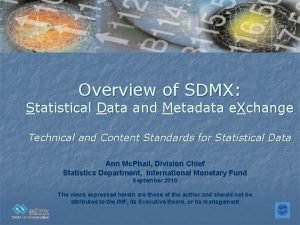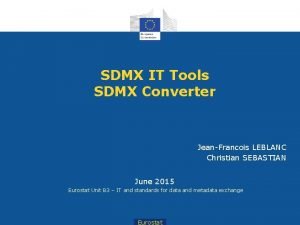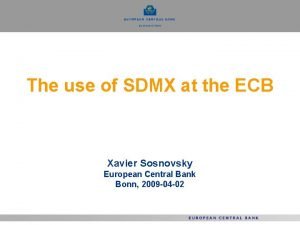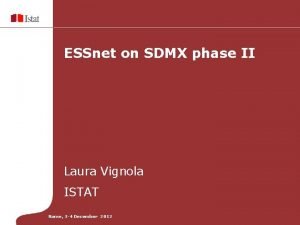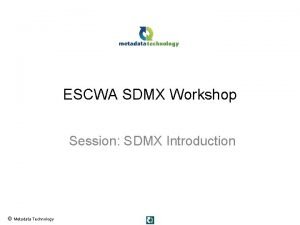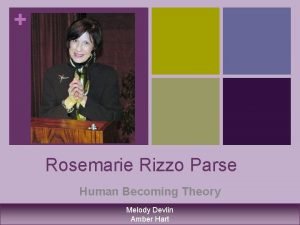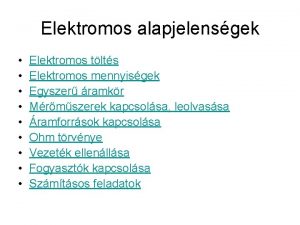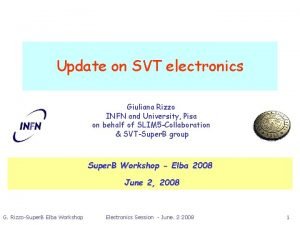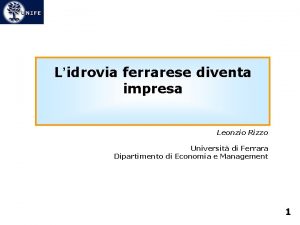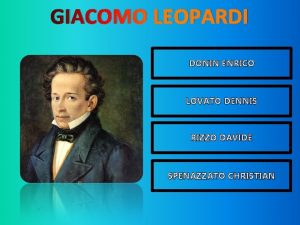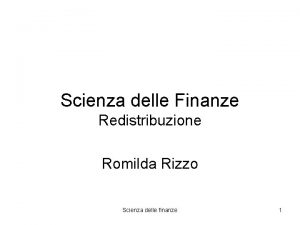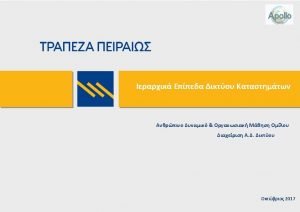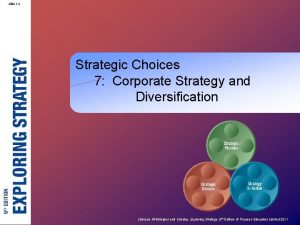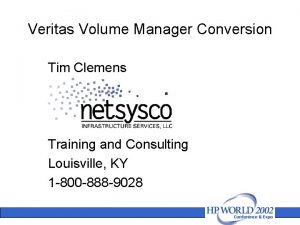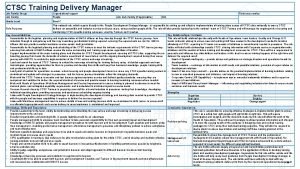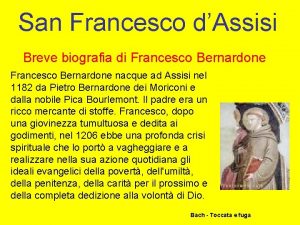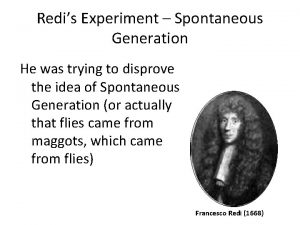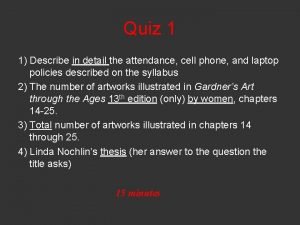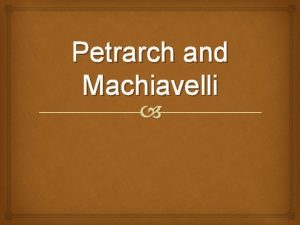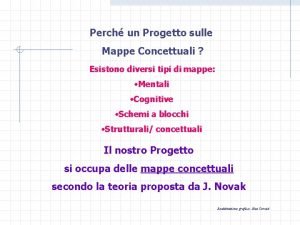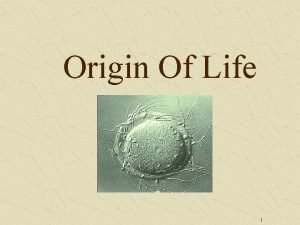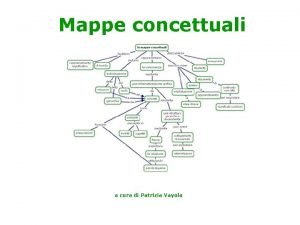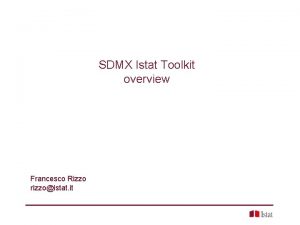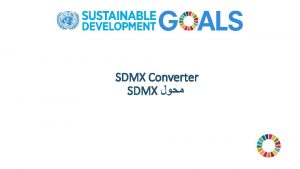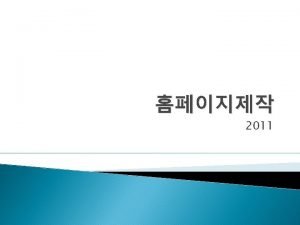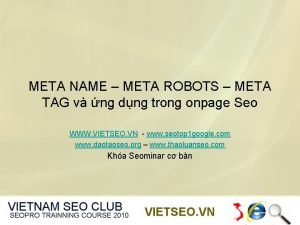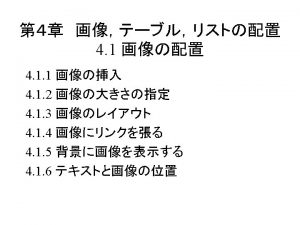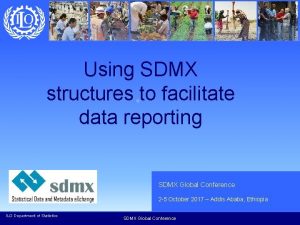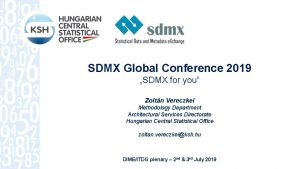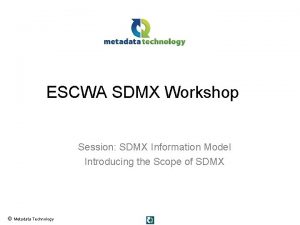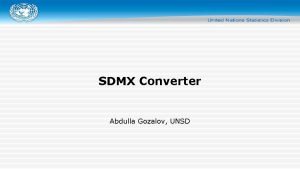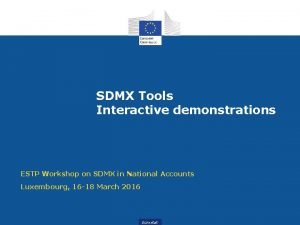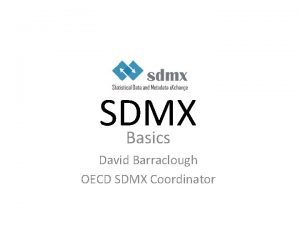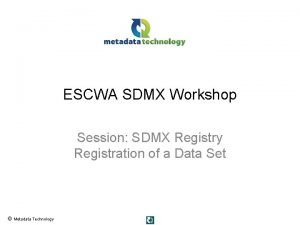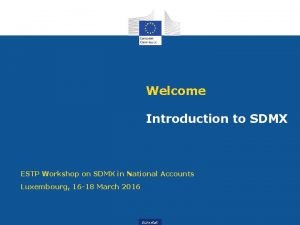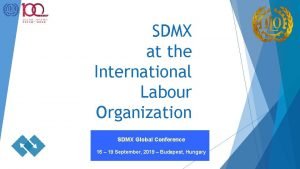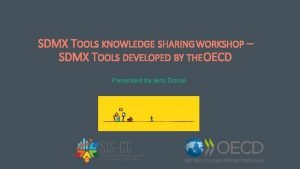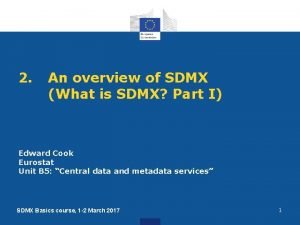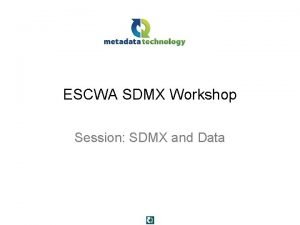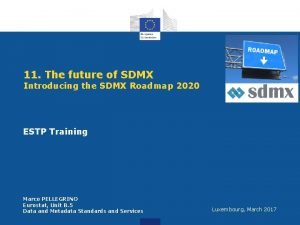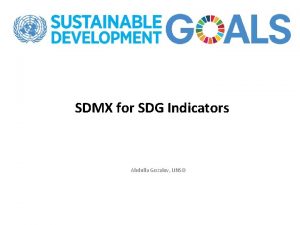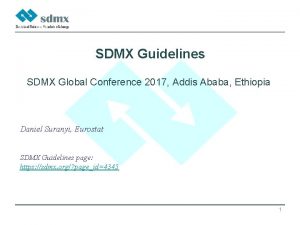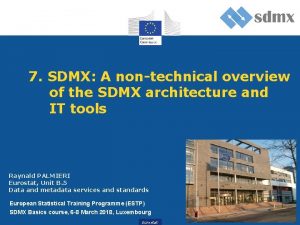SDMX training Francesco Rizzo rizzoistat it Meta Manager


















![Import Codelists from SDMX-ML files (1/2) 1. Click on the button [Import Structure] 2. Import Codelists from SDMX-ML files (1/2) 1. Click on the button [Import Structure] 2.](https://slidetodoc.com/presentation_image/3cf1e292a7a0d52e295521a308dd877e/image-19.jpg)









![Create a DSD - Add the Dimensions (1/3) 1. Click on the button [+Add] Create a DSD - Add the Dimensions (1/3) 1. Click on the button [+Add]](https://slidetodoc.com/presentation_image/3cf1e292a7a0d52e295521a308dd877e/image-29.jpg)


![Create a DSD - Add the Attributes (1/3) 1. Click on the button [+Add] Create a DSD - Add the Attributes (1/3) 1. Click on the button [+Add]](https://slidetodoc.com/presentation_image/3cf1e292a7a0d52e295521a308dd877e/image-32.jpg)



- Slides: 35

SDMX training Francesco Rizzo rizzo@istat. it Meta Manager: developing SDMX artefacts for Handicraft enterprises table

Istat SDMX Meta Manager q it interacts with the Metadata Repository (via the SDMX Web service in SOAP and REST) and provides a graphical user interface for browsing, download, create and submit (only with SOAP) structural metadata q it can switch among different SDMX Web Services, therefore a user can browse metadata stored in different repositories, such as the Global registry, Eurostat registry, ECB registry, UN data, World bank, Istat, etc. q at the moment it allows to create interactively Codelists, Conceptscheme, Data Structure Definitions, Categoryschemes and Dataflows q it allows to overcome some SDMX constraints, and modify finalized item scheme artefacts (e. g. Codelists, Conceptschemes, Categoryschemes): q Add new items (delete is not allowed) q Modify name, description, annotations, etc. q Handle the order and hierarchy of the items q Move a Dataflow from a Category to a another, or between different Categoryschemes This application can also be used for building “nomenclature” servers, such as classifications servers and glossaries

Handicraft enterprises active, by section of economic activity

Handicraft enterprises active, by juridical form

Demography of handicraft enterprises

Matrix _Z = not applicable

Statistical concepts and Codelists Concept id FREQ GEO SEZNACE LEGALFORM DEMOENT TIME_PERIOD OBS_VALUE SOURCE Concept name Frequency Territory NACE Sections Legal form Demography of enterprise Time period Observed value Source Codelist id CL_FREQ CL_GEO CL_SEZNACE CL_LEGALFORM CL_ DEMOENT CL_SOURCE Codelist name Frequency Territory NACE sections Legal form Demography of enterprises Source

Starting the Meta Manager application n http: //localhost/metamanager (4) (3) (1) (2) (5) (6) 1. select from several web service 2. verify that the connection took place correctly (green color) or the connection was not achieved (red color) (*) 3. change language 4. Authenticate 5. select the artefact typology from the left side menu 6. the “Dataflows & Category Scheme” menu’s voice is shown only after an authentication and it is used for management purpose and not for dissemination

Authentication and authorization n The authentication and authorization mechanism is managed throgh an XML file. n The authentication is achieved providing the user-id and password n The authorization is per Agency. n User 1 can create/modify artefacts with agency SDMX and ESTAT, and can visualize/download artefacts with agency IT 1 and IT 2. User 2 can create/modify artefacts with agency IT 1 and It 2, and can visualize/download artefacts with agency SDMX and ESTAT

Add a Codelist General information Details for each item

How to create a new Code list (1/3) 1. Click on the button [+ Create Artefact] 2. Insert the following information: q q ID = CL_FREQ Agency ID= IT 1 Version=1. 0 Name [en] = Frequency 3. Click on the row that contains the CL_FREQ, IT 1, 1. 0

How to create a new Code list (2/3) 4. Click on the button “add root item” (1) 5. Add the following information: ID: A Name [en]: Annual 6. Repeat steps 4 and 5 and add the other items

How to create a new Code list (3/3) q The picture below shows the Code list CL_FREQ with its items q The icon is inserted automatically and it stores the order of each item

How to modify a Code list q To modify or delete an item, click right on the item and a menu will be opened q (1) allows to ad a child item under in order to create a hierarchy q (2) allows to modify an item. In this case the following windows will be opened (*) q (3) allows to delete an item

Create the Codelist CL_DEMOENT n Create a new Codelist with the following general information: n n ID = CL_DEMOENT Agency ID= IT 1 Version=1. 0 Name [en] = Demography of the enterprise n Add the following items:

Import a Codelist from a CSV

Import a Codelist from a CSV file (1/2) 1. Create a new Codelist with the following general information: n n ID = CL_LEGALFORM; Agency ID= IT 1 Version=1. 0 Name [en] = Legal form 2. Go in the details window to add items

Create a Codelist from a CSV file (2/2) 3. Click on the icon to import a CSV file 4. Select and import the file : [en]CL_LEGALFORM+IT 1+1. 0. csv (*)
![Import Codelists from SDMXML files 12 1 Click on the button Import Structure 2 Import Codelists from SDMX-ML files (1/2) 1. Click on the button [Import Structure] 2.](https://slidetodoc.com/presentation_image/3cf1e292a7a0d52e295521a308dd877e/image-19.jpg)
Import Codelists from SDMX-ML files (1/2) 1. Click on the button [Import Structure] 2. Import the file: CL_GEO+IT 1+1. 0. xml

Import Codelists from SDMX-ML files 1. Repeat steps 1 and 2 for the following files n CL_SEZNACE+IT 1+1. 0. xml n CL_SOURCE+IT 1+1. 0. xml

Add a Conceptscheme General information Details for each item

How to create a new Conceptscheme (1/3) 1. Click on the button [+ Create Artefact] 2. Insert the following information: q q ID = HANDI_SCHEME Agency ID= IT 1 Version=1. 0 Name [en] = Handicraft enterprises Concepts 3. Click on the row that contains the HANDI_SCHEME, IT 1, 1. 0

How to create a new Conceptscheme (2/3) 4. Click on the button “add root item” (1) 5. Add the following information: ID: FREQ Name [en]: Frequency 6. Repeat steps 4 and 5 and add the other items

How to create a new Conceptscheme (3/3) q The picture below shows the Conceptscheme STS_SHEME with its items q The icon is inserted automatically and it stores the order of each item

How to modify a Conceptscheme q To modify or delete an item, click right on the item and a menu will be opened q (1) allows to ad a child item under in order to create a hierarchy q (2) allows to modify an item. In this case the following windows will be opened (*) q (3) allows to delete an item

Create a Data Structure Definition – Message Implementation Guide

Create a DSD - Add the general part n Before creating a new DSD, the related Concept schemes and Code lists must be finalized 1. Select on the right side the menu [Data structure] 2. Click on the button [+ Create Artefact] id HANDICRAFT Name (en) Handicraft enterprises version 1. 0 agency. ID IT 1

Create a DSD - Add the Primary measure 1. Click on the icon Concept (3) to select the Conceptscheme (2) and the
![Create a DSD Add the Dimensions 13 1 Click on the button Add Create a DSD - Add the Dimensions (1/3) 1. Click on the button [+Add]](https://slidetodoc.com/presentation_image/3cf1e292a7a0d52e295521a308dd877e/image-29.jpg)
Create a DSD - Add the Dimensions (1/3) 1. Click on the button [+Add] to add a new Dimension

Create a DSD - Add the Dimensions (2/3) 1. Select the dimension Type (*): 2. Select the Concept scheme and the related concept (**) 3. Select a Codelist, in case the concept is coded

Create a DSD - Add the Dimensions (3/3) q Add all the following dimensions
![Create a DSD Add the Attributes 13 1 Click on the button Add Create a DSD - Add the Attributes (1/3) 1. Click on the button [+Add]](https://slidetodoc.com/presentation_image/3cf1e292a7a0d52e295521a308dd877e/image-32.jpg)
Create a DSD - Add the Attributes (1/3) 1. Click on the button [+Add] to add a new Attribute

Create a DSD - Add the Attributes (2/3) 1. 2. 3. 4. Select the Concept scheme and the related concept (*) Select a Codelist, in case the concept is coded Select the assignment status Select the attachement level

Create a DSD - Add the Attributes (3/3) 1. Add the attribute “Source” as follows:

Create a DSD – Finalize, save, etc. 1. 2. 3. 4. Finalize Save Duplicate Download
 Meta synthesis vs meta analysis
Meta synthesis vs meta analysis Sdmx excel
Sdmx excel Http://sdmx.store:8080
Http://sdmx.store:8080 Sdmx converter
Sdmx converter Ecb sdmx
Ecb sdmx Laura vignola
Laura vignola Sdmx converter
Sdmx converter Rosemarie rizzo parse
Rosemarie rizzo parse Human becoming theory example
Human becoming theory example Oscar rizzo
Oscar rizzo Lead time bias คือ
Lead time bias คือ Ronii rizzo
Ronii rizzo Rizzó
Rizzó Svt electronics
Svt electronics Leonzio rizzo
Leonzio rizzo Jenny rizzo
Jenny rizzo Le qualità poetiche dell'indefinito
Le qualità poetiche dell'indefinito Romilda rizzo
Romilda rizzo Carmine rizzo
Carmine rizzo Senior manager vs general manager
Senior manager vs general manager Portfolio manager synergy manager parental developer
Portfolio manager synergy manager parental developer Veritas volume manager tutorial
Veritas volume manager tutorial Notam manager training
Notam manager training Ucla general accounting fund managers
Ucla general accounting fund managers Street manager business rules
Street manager business rules Ucla epass
Ucla epass Faa notam manager
Faa notam manager Ctsc training
Ctsc training Francesco d'assisi breve biografia
Francesco d'assisi breve biografia Redi's experiment
Redi's experiment Francesco traini
Francesco traini Francesco petrarch wrote the prince
Francesco petrarch wrote the prince Laudato si' mappa concettuale
Laudato si' mappa concettuale Spallanzani experiment
Spallanzani experiment Mappa concettuale sulle teorie dell'apprendimento
Mappa concettuale sulle teorie dell'apprendimento Liceo classico petrarca
Liceo classico petrarca

